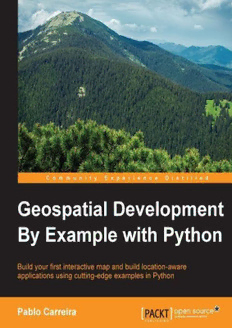
Geospatial Development By Example with Python PDF
Preview Geospatial Development By Example with Python
Geospatial Development By Example with Python Table of Contents Geospatial Development By Example with Python Credits About the Author About the Reviewers www.PacktPub.com Support files, eBooks, discount offers, and more Why subscribe? Free access for Packt account holders Preface What this book covers What you need for this book Who this book is for Conventions Reader feedback Customer support Downloading the example code Downloading the color images of this book Errata Piracy Questions 1. Preparing the Work Environment Installing Python Windows Ubuntu Linux Python packages and package manager The repository of Python packages for Windows Installing packages and required software OpenCV Windows Ubuntu Linux Installing NumPy Windows Ubuntu Linux Installing GDAL and OGR Windows Ubuntu Linux Installing Mapnik Windows Ubuntu Linux Installing Shapely Windows Ubuntu Linux Installing other packages directly from pip Windows Ubuntu Linux Installing an IDE Windows Linux Creating the book project Programming and running your first example Transforming the coordinate system and calculating the area of all countries Sort the countries by area size Summary 2. The Geocaching App Building the basic application structure Creating the application tree structure Functions and methods Documenting your code Creating the application entry point Downloading geocaching data Geocaching data sources Fetching information from a REST API Downloading data from a URL Downloading data manually Opening the file and getting its contents Preparing the content for analysis Combining functions into an application Setting your current location Finding the closest point Summary 3. Combining Multiple Data Sources Representing geographic data Representing geometries Making data homogeneous The concept of abstraction Abstracting the geocache point Abstracting geocaching data Importing geocaching data Reading GPX attributes Returning the homogeneous data Converting the data into Geocache objects Merging multiple sources of data Integrating new functionality into the application Summary 4. Improving the App Search Capabilities Working with polygons Knowing well-known text Using Shapely to handle geometries Importing polygons Getting the attributes’ values Importing lines Converting the spatial reference system and units Geometry relationships Touches Crosses Contains Within Equals or almost equals Intersects Disjoint Filtering by attributes and relations Filtering by multiple attributes Chaining filters Integrating with the app Summary 5. Making Maps Knowing Mapnik Making a map with pure Python Making a map with a style sheet Creating utility functions to generate maps Changing the data source at runtime Automatically previewing the map Styling maps Map style Polygon style Line styles Text styles Adding layers to the map Point styles Using Python objects as a source of data Exporting geo objects Creating the Map Maker app Using PythonDatasource Using the app with filtering Summary 6. Working with Remote Sensing Images Understanding how images are represented Opening images with OpenCV Knowing numerical types Processing remote sensing images and data Mosaicking images Adjusting the values of the images Cropping an image Creating a shaded relief image Building an image processing pipeline Creating a RasterData class Summary 7. Extract Information from Raster Data Getting the basic statistics Preparing the data Printing simple information Formatting the output information Calculating quartiles, histograms, and other statistics Making statistics a lazy property Creating color classified images Choosing the right colors for a map Blending images Showing statistics with colors Using the histogram to colorize the image Summary 8. Data Miner App Measuring execution time Code profiling Storing information on a database Creating an Object Relational Mapping Preparing the environment Changing our models Customizing a manager Generating the tables and importing data Filtering the data Importing massive amount of data Optimizing database inserts Optimizing data parsing Importing OpenStreetMap points of interest Removing the test data Populating the database with real data Searching for data and crossing information Filtering using boundaries Summary 9. Processing Big Images Working with satellite images Getting Landsat 8 images Memory and images Processing images in chunks Using GDAL to open images Iterating through the whole image Creating image compositions True color compositions Processing specific regions False color compositions Summary 10. Parallel Processing Multiprocessing basics Block iteration Improving the image resolution Image resampling Pan sharpening Summary Index
